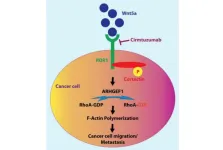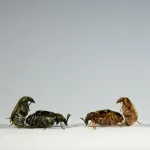(Press-News.org) Earth is a dynamic and constantly changing planet. From the formation of mountains and oceans to the eruption of volcanoes, the surface of our planet is in a constant state of flux. At the heart of these changes lies the powerful force of plate tectonics—the movements of Earth’s crustal plates. This fundamental process has shaped the current topography of our planet and continues to play a role in its future.
But what was plate tectonic activity like during early Earth? And was the process even occurring during the time when life is thought to have formed?
“The dynamic tectonic nature of the modern Earth is one of the reasons why life exists today,” says Wriju Chowdhury, a postdoctoral research associate in the lab of Dustin Trail, an associate professor of earth and environmental sciences at the University of Rochester. “Exploring the geodynamics and the lithological diversity of the early Earth could lead to revelations of how life first began on our planet.”
Chowdhury is the first author of a paper published in Nature Communications that outlines how Rochester researchers used small zircon crystals to unlock information about magmas and plate tectonic activity in early Earth. The research provides chemical evidence that plate tectonics was most likely occurring more than 4.2 billion years ago when life is thought to have first formed on our planet. This finding could prove beneficial in the search for life on other planets.
Plate tectonics power the creation and destruction of Earth’s crust
Plate tectonics on modern Earth is “extremely important,” Trail says, because it is “the dominant mechanism for the creation and destruction of Earth’s crust.”
Earth is the only known planet that has a mobile upper crust that is cyclically destroyed and created. The process delivers critical elements, such as iron and magnesium, from the interior of the earth to its surface and controls Earth’s water and carbon cycles. But, more importantly to geologists, plate tectonics melts and mixes rocks to create magmas with specific chemical makeups, depending on the rocks involved and the location where the “destruction” occurred. The chemical makeup of magma can therefore indicate the style of tectonics that created it.
Ancient crystals as tiny time capsules
Chowdhury and his colleagues conducted their research using zircons—tiny crystals in rocks that are like small time capsules. The zircons contain trace amounts of chemical elements, locked into the crystals at the time when the crystals were formed. The researchers date the zircons and then work backward, with zircons revealing information about the chemical makeup of the parent magmas from which the zircons crystallized. Researchers then use information about the magmas to reconstruct the physical and chemical environment—and to infer plate tectonic styles—of the early Earth, during the time when the zircons formed. In this case, the zircons were around 3.8 to 4.2 billion years old.
According to Chowdhury, most researchers infer information about early Earth using zircons to create probabilistic models to present different tectonic scenarios. Chowdhury and his colleagues went a step further to describe not only the zircons but also the parent magmas.
“Parent magmas are much more direct and reliable because they are closer to the source—the actual tectonic style,” Chowdhury says. “Our study describes the silicon and oxygen isotopic content of the zircons and the trace element content of the parental magmas, which has not been combined and presented before.”
Chowdhury, Trail, and their colleagues found chemical similarities between early Earth magmas and modern magmas created at tectonically active plate boundaries such as the Cascade and Aleutian Island chains or areas in Japan and the Andes Mountains.
“This suggests tectonic continuity from the ancient to modern times,” Trail says. “That is, our study shows the earth, billions of years ago, might have operated similarly as it does today.”
A key characteristic of a habitable planet
The researchers did not determine whether life existed when plate tectonics began—“neither life nor tectonics have an accurate start date yet,” Chowdhury says, noting that the geology community is divided on these points. But the new data provides chemical evidence suggesting that plate tectonics could have been occurring more than 4.2 billion years ago.
Whatever the case, he continues, plate tectonics is a key reason why Earth currently has a temperate living environment—and could be an important factor in the search for habitable living environments on other planets.
“The chances for life to originate increase manifold if there is some planetary dynamism,” he says.
END
Was plate tectonics occurring when life first formed on Earth?
Zircon crystals and magmas reveal new information about plate tectonic activity on Earth billions of years ago.
2023-04-04
ELSE PRESS RELEASES FROM THIS DATE:
AI tool gains doctors’ trust by giving advice like a colleague
2023-04-04
ITHACA, N.Y. – A new Cornell University-led study suggests that if artificial intelligence tools can counsel a doctor like a colleague – pointing out relevant research that supports the decision – then doctors can better weigh the merits of the recommendation.
The researchers will present the new study in April at the Association for Computing Machinery CHI Conference on Human Factors in Computing Systems.
Previously, most AI researchers have tried to help doctors evaluate suggestions from decision support tools by explaining how the underlying algorithm works, or what data was used to train the AI. But an ...
The American College of Chest Physicians warns of impact of Braidwood Management ruling
2023-04-04
The American College of Chest Physicians (CHEST) opposes the federal court’s March 30, 2023, ruling in Braidwood Management Inc. v. Becerra and applauds the Department of Justice for acting so swiftly to appeal this decision. Judge O’Connor’s remedies strip the guarantee of no-cost preventative benefits away from the 151 million people insured by the Affordable Care Act (ACA) and currently have access to care, such as smoking cessation services, guideline-indicated lung cancer screening, and tuberculosis testing.
“CHEST’s ...
Chen Institute partners with ISSCR to establish fellowship for Stem Cell Reports Early Career Editorial Board
2023-04-04
The International Society for Stem Cell Research (ISSCR) is delighted to announce a partnership with the Tianqiao and Chrissy Chen Institute, establishing a fellowship program to support members of the Stem Cell Reports Early Career Editorial Board (ECEB). The program facilitates attendance at the ISSCR Annual Meeting, mentoring opportunities, and the development of scientific programs that will cultivate and deepen leadership skills.
The Chen Institute Fellowship is designed to directly support ECEB members financially and in career growth. Broadly, activities supported by ...
Oncotarget at AACR Annual Meeting 2023
2023-04-04
Impact Journals (Oncotarget's publisher) is proud to participate at the American Association for Cancer Research (AACR) Annual Meeting 2023, which convenes April 14-19 in Orlando, Florida.
BUFFALO, NY-April 4, 2023 – Impact Journals will be participating as an exhibitor at the American Association for Cancer Research (AACR) Annual Meeting 2023 from April 14-19 at the Orange County Convention Center in Orlando, Florida. This year, the AACR meeting theme is: “Advancing ...
Forsyth microbiologists discover a regulatory mechanism that keeps cancer-causing bacteria in check
2023-04-04
Cambridge, Mass. - Researchers at the Forsyth Institute have discovered an important mechanism that may have profound implications for how we prevent colorectal cancer. Oddly enough, their discovery began in the mouth.
Colorectal cancer is the second most deadly cancer, killing over 52,000 people a year. Increasing evidence indicates Fusobacterium nucleatum, an opportunistic oral pathogen is one of the factors causing colorectal cancer. Fusobacteria are often found in healthy mouths, living in balance ...
Traumatic brain injury interferes with immune system cells’ recycling process in brain cells
2023-04-04
Each year about 1.5 million people in the U.S. survive a traumatic brain injury due to a fall, car accident, or a sports injury, which can cause immediate and long-term disability.
University of Maryland School of Medicine (UMSOM) researchers wanted to better understand what happens in the brain during injury, so they conducted a study in mice to determine how different types of brain cells in mice react to severe trauma. In a new study published in the January issue of Autophagy, they found that after traumatic brain injury, the brain’s immune system cells’ internal recycling ...
Rats! Rodents seem to make the same logical errors humans do
2023-04-04
Animals, like humans, appear to be troubled by a Linda problem.
The famous “Linda problem” was designed by psychologists to illustrate how people fall prey to what is known as the conjunction fallacy: the incorrect reasoning that if two events sometimes occur in conjunction, they are more likely to occur together than either event is to occur alone.
Now, for the first time, UCLA psychology researchers have shown that this type of logical error isn’t the sole province of humans ...
Impact of cortactin in cancer progression
2023-04-04
“Cortactin (also known as EMS1 or CTTN) is expressed broadly in a variety of cancers [...]”
BUFFALO, NY- April 4, 2023 – A new editorial paper was published in Oncotarget's Volume 14 on March 21, 2023, entitled, “Impact of cortactin in cancer progression on Wnt5a/ROR1 signaling pathway.”
In this editorial, researchers Kamrul Hasan and Thomas J. Kipps from the University of California discuss cortactin—an intracellular cytoskeletal protein that can undergo tyrosine phosphorylation upon external stimulation and promote polymerization and the assembly of the actin filament that is required for cell migration. Upon stimulation, cortactin ...
Male beetles neglect their genomes when competing for females
2023-04-04
Male beetles face a trade-off between competing with other males for mating opportunities and repairing damage to their sperm DNA, according to a study publishing April 4th in the open access journal PLOS Biology by Mareike Koppik from Uppsala University, Sweden, and colleagues.
Mutations in sperm and egg DNA can reduce the survival and fitness of offspring, so animals use a variety of repair and maintenance mechanisms in their reproductive cells. However, previous research has shown that sperm DNA has more mutations than egg DNA in a variety of ...
Studies ask: what does “multimorbidity” mean and how much does it cost us?
2023-04-04
The prevalence of multimorbidity, the co-occurrence of two or more chronic conditions, varies depending on exactly how it is defined. And the healthcare costs associated with many disease combinations cost more together than the sum of each individual disease. Those are the conclusions of two new studies, publishing April 4th in the open access journal PLOS Medicine, that broadly analyze the concept and costs of multimorbidity.
Multimorbidity is increasing in prevalence due to improved survival from chronic diseases and population aging, and now poses major challenges to healthcare systems worldwide. ...
LAST 30 PRESS RELEASES:
Post-stroke injection protects the brain in preclinical study
Cardiovascular risk score predicts multiple eye diseases
Health: estimated one in ten British adults used or interested in GLP-1 medications for weight loss
Exercise to treat depression yields similar results to therapy
Whooping cough vaccination for pregnant women strengthens babies’ immune system
Dramatic decline in new cases of orphanhood in Uganda driven by HIV treatment and prevention programs
Stopping weight loss drugs linked to weight regain and reversal of heart health markers
Higher intake of food preservatives linked to increased cancer risk
Mass General Brigham–developed cholera vaccine completes phase 1 trial
First experimental validation of a “150-year-old chemical common sense” direct visualization of the molecular structural changes in the ultrafast anthracene [4+4] photocycloaddition reaction
Lack of support for people on weight loss drugs leaves them vulnerable to nutritional deficiencies, say experts
Dogs’ dinners can have greater climate impact than owners’
Are you ready to swap salmon for sprats and sardines?
1.6 million UK adults used weight loss drugs in past year
American College of Cardiology comments on new dietary guidelines for Americans
American Society of Gene & Cell Therapy and Orphan Therapeutics Accelerator partner to advance and commercialize promising rare disease treatments
One in 14 patients having day case surgery have new or worse chronic pain 3 months after their operation
New study highlights link between eviction rates and gun violence
Heatwaves heat up soil but not toxin levels in rice, study finds
Digital modeling reveals where construction carbon emissions really come from
Turning farm waste into water filters
New study shows how the spleen helps the immune system accept a transplant
New Mayo Clinic study advances personalized prostate cancer education with an EHR-integrated AI agent
Researchers identify novel therapeutic target to improve recovery after nerve injury
Microbes in breast milk help populate infant gut microbiomes
Reprogramming immunity to rewrite the story of Type 1 diabetes
New tool narrows the search for ideal material structures
Artificial saliva containing sugarcane protein helps protect the teeth of patients with head and neck cancer
Understanding the role of linear ubiquitination in T-tubule biogenesis
Researchers identify urban atmosphere as primary reservoir of microplastics
[Press-News.org] Was plate tectonics occurring when life first formed on Earth?Zircon crystals and magmas reveal new information about plate tectonic activity on Earth billions of years ago.




